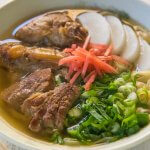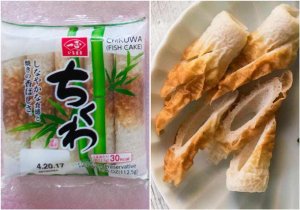
Okinawa Soba (Sōki Soba) is a famous home-cooking dish in Okinawa. Sweet and tender pork ribs on top of egg noodles in broth that is made from pork ribs and bonito flakes. It is a hearty and flavoursome noodle soup. The pork ribs melt in your mouth.
You can make Simmered Soki and soba broth ahead of time.
- 400g/0.9lb egg noodles (note 1)
- 120g/5.3oz kamaboko or chikuwa , sliced to 7mm/¼" thick (note 2)
- 8 tbsp finely chopped shallots/scallions
- 4 tbsp beni shōga (note 3)
- 1kg/2.2lb pork rib strips (note 4)
- 30g/1.1oz ginger , sliced
- 1400 ml broth from boiling pork (note 6)
- 10g/0.4oz bonito flakes (note 7)
- 2 tsp salt
- 2 tsp soy sauce
- 2 tbsp mirin
- 1 tsp sake (note 5)
-
Cut pork rib strip between the rib bones so that each piece gets meat with a bone (note 8).
-
Put the pork pieces in a pot and fill with water to fully cover the pork.
-
Bring it to a boil and cook for 5 minutes. Drain and discard the fluid. Rinse the pork pieces ensuring that scum is removed.
-
Remove the scums from the pot cleanly, return the pork to the pot and add ginger pieces.
-
Fill water to fully cover the pork pieces and bring it to a boil. Reduce heat to low and simmer for 1.5 hours with a lid on, until the pork becomes very tender but not breaking easily.
-
Remove the pork pieces from the pot and keep the broth.
-
Transfer the pork pieces to another large pot or a frying pan, preferably large enough to place the pork pieces in without overlapping.
-
Add the Sōki Flavouring ingredients to the pot/pan with the pork and bring it to a boil.
-
Reduce the heat to low and cook for about 5 minutes, turning the pork pieces over so that the flavour coats them.
-
Bring the heat to high and continue to cook until the sauce almost evaporates. Turn the heat off.
-
Add bonito flakes to the broth and bring it to a boil. Reduce the heat to simmer and cook for few minutes.
-
Put the broth through a sieve to remove ginger, bonito flakes and tiny pork bits (note 9).
-
Add the remaining Soba Broth ingredients and bring it to a boil. Turn the heat off.
-
Boil water in a pot and cook noodles as per the instructions on the pack.
-
Drain water well and place noodles in each serving bowl.
-
Pour 350ml of the soba broth into each of the bowls, topped with the simmered sōki, kamoaboko/chikuwa and shallots. Serve immediately.
1. Traditional Okinawan noodles are thicker than ramen noodles. Sometimes flat noodles (similar to fettuccini) are used as well.
You can use thick egg noodles from Asian grocery stores but do not use oily thick egg nooddles that are used to make Hokkien Noodles.
Alternatively, you can use Shanghai noodles that are whitish and are similar to udon. They are available at Asina grocery stores. If you are in NSW, they are also sold at Harris Farm Markets.
2. Kamaboko is a steamed fish cake and usually comes in a semi-cylinder shape (see the photo in the post), while chikuwa (photo below) is broiled after fish paste is wrapped around a stick and comes as a tube. They are sold in the frozen section of Japanese/Asian grocery stores.
If using chikuwa, diagonally slice each tube like the photo below.

3. Beni shōga is red pickled ginger which usually comes in shredded form. You can buy beni shōga at Japanese/Asian grocery stores, possibly at some supermarkets. Please visit Japanese Beef Bowl (Gyū-don) for more details with photos.
4. The bones attached to the pork rib strip can be hard bones or soft bones. For the best result, the width of the strip should be 5-7cm/2-2¾”.
5. If you have access to ‘awamori’ (泡盛), which is an indigenous Okinawan local sake, you may want to use awamori instead. Compared to sake, it has a richer and mellow scent and is marginally sweeter.
6. If not enough, add water.
7. I use a spice bag or a disposable dashi bag that you can buy at Japanese grocery stores, particularly if your bonito flakes contain tiny powdery bits. Using a bag will maintain the clarity of the broth better. See the recipe notes section of Home-made Ramen Broth Recipe for the sample photo of disposable dashi bag.
8. If you can only find a narrow strip, you may want to cut it at every alternate rib bone so that the size of each pork piece is not too small.
9. Unless I am serving to friends or visitors, I use a fine mesh skimmer spoon to remove bits the broth so that I needn't use another container with a strainer.